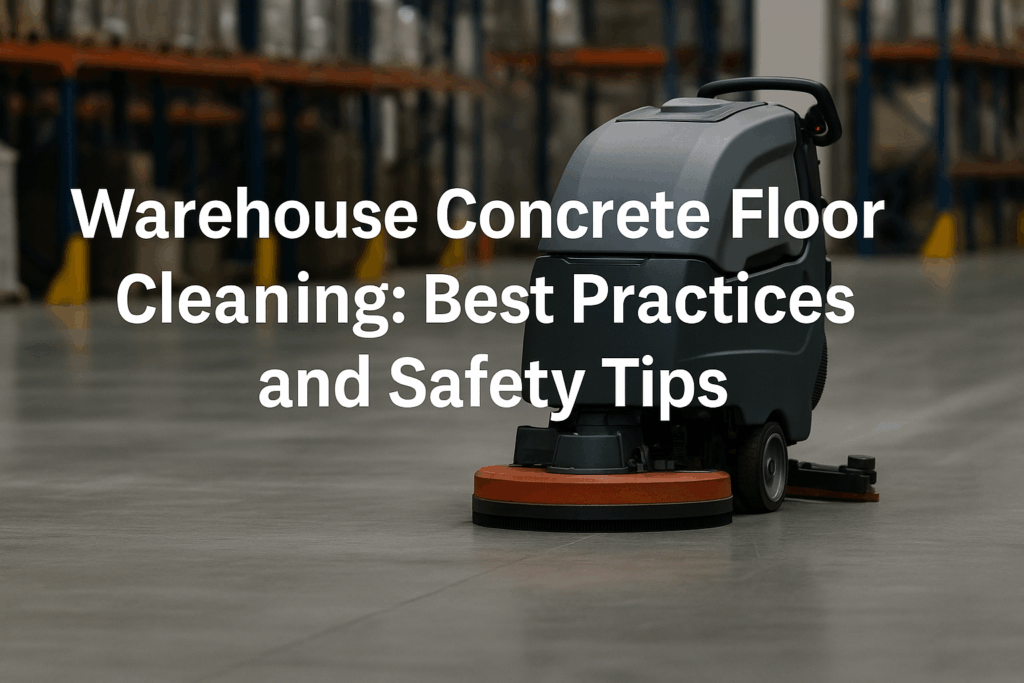
Beyond safety and efficiency, a polished, spotless warehouse makes a strong impression on clients, partners, and inspectors.
This guide takes a detailed look at warehouse concrete floor cleaning. You’ll find practical cleaning methods, safety tips, maintenance schedules, and answers to common questions. It also highlights the role of professional services like TCS Floors, a trusted name in industrial and commercial floor care.
By the end, you’ll have a complete roadmap for creating a clean, safe, and long-lasting warehouse floor system.
Why Warehouse Concrete Floor Cleaning Matters
Every forklift, pallet jack, and worker depends on them for safe and efficient movement. When floors are left dirty or neglected, the risks increase and the overall performance of the facility suffers.
Here are the key reasons cleaning matters:
- Worker Safety: Slips, trips, and falls are among the most common workplace accidents. Dust, spilled oil, and scattered debris make warehouse floors hazardous. A regular cleaning schedule removes these risks, ensuring employees can move with confidence. Clean floors also make safety markings, such as pedestrian lanes and hazard zones, easier to see, further reducing accidents.
- Equipment Efficiency: Forklifts, carts, and conveyors take a beating when floors are cluttered with dust or grit. Over time, dirt can damage wheels and bearings, leading to more frequent repairs. By keeping concrete floors free of debris, managers extend the life of expensive equipment and cut down on costly downtime.
- Air Quality and Dust Control: Concrete floors naturally shed fine dust as they wear, which can circulate through the warehouse. This “concrete dusting” irritates workers’ lungs, settles on inventory, and can even damage sensitive equipment. Proper floor cleaning and sealing prevent dust from becoming airborne, improving both worker health and product quality.
- Longevity of the Floor: Concrete may seem indestructible, but without proper care it deteriorates. Chemicals, oils, and constant wear can cause staining, cracking, and surface breakdown. Regular cleaning paired with periodic sealing or coating extends the life of the floor, saving warehouses from costly resurfacing or replacement.
- Professional Appearance: Clients, partners, and inspectors notice first impressions. A clean warehouse floor communicates that the facility is well-run, safe, and professional. For businesses in industries with strict compliance standards, such as food storage or pharmaceuticals, spotless floors are not just an option, they’re a requirement.
Understanding Industrial Concrete Floor Care
Warehouse concrete floors can vary in finish and wear. Knowing your floor type helps you choose the right cleaning approach:
| Floor type | Traits | Typical issues | Cleaning approach | Watch-outs |
| Unfinished / raw concrete | Porous; absorbs oils, grease, and chemicals | Oil/grease spills, dust buildup, rust/chemical stains, heavy debris | Can handle stronger cleaning agents; mechanical agitation as needed; may require resealing after deep cleans | Staining penetrates quickly; plan for periodic sealing to reduce absorption |
| Sealed or polished concrete | Less porous; easier to clean | Tire marks/scuffing, dust, tracked-in dirt; can be slippery when wet | Use pH-neutral cleaners and soft scrubbing to protect the finish | Avoid harsh or abrasive methods that can dull the polish; manage wet-floor slip risk |
| Epoxy or polyaspartic coatings | Durable; chemical-resistant; common in high-traffic zones | Tire marks/scuffing, oil/grease, chemical spots, debris | Clean with neutral chemicals to preserve shine and coating integrity | Strong solvents or abrasive pads can haze or wear the coating |
| Specialized floors (terrazzo, rubber, etc.) | Each surface has unique care needs | Varies by material | Follow material-specific products and methods recommended for that surface | Test in a small area first; mismatched cleaners can discolor or damage the floor |
Methods of Warehouse Concrete Floor Cleaning
This section outlines practical techniques, from quick daily care to major restoration. Match the method to your floor type (raw concrete, sealed/polished, epoxy/polyaspartic, or specialized surfaces).
Dry Cleaning & Debris Removal
Dry cleaning lifts grit and fine dust before it can scratch coatings or leave a film that turns slick when damp. It’s the fastest way to keep aisles safe and prepare the floor for any wet process.
What to use
In small zones and along edges, push brooms and dust mops work well. Large aisles benefit from ride-on or walk-behind sweepers. Where fine concrete dust is common, industrial vacuums—ideally with HEPA filters—pull dust out of joints, corners, and pallet lanes.
How to do it
Start in cleaner zones and move toward dirtier areas to avoid re-tracking. Overlap each pass so you don’t leave dust lines. Vacuum expansion joints, dock plates, and under low racking on a routine cadence; daily in dusty sites, weekly in lighter environments.
How often
High-traffic aisles may need attention multiple times per shift. Receiving and staging areas usually need a pass at the end of each shift. Low-traffic storage rows can be handled daily or every other day based on soil loads.
What to watch for
Replace worn broom heads and sweeper brushes—their ends mushroom and start pushing dust rather than lifting it. Keep vacuum filters clean so suction stays consistent.
Wet Cleaning & Auto Scrubbing
Move to wet cleaning when you see tire residue, gray film after sweeping, or any buildup that raises slip risk. It’s also standard practice in food, packaging, and hygiene-sensitive zones.
What to use
Auto scrubbers fitted with soft pads or nylon brushes clean and recover in one pass. Polished or sealed concrete and resinous floors (epoxy, polyaspartic) pair best with soft white or red pads or light-duty brushes. Raw concrete can take a medium brush. Good squeegee blades matter; they prevent streaks and leftover slurry.
How to do it
Pre-treat heavy soil with a light spray of cleaner and give it a short dwell so chemistry can work. Set solution flow so the surface stays wet under the head without leaving deep puddles. Two slower passes (one to scrub and one to recover) beat a single fast lap. For tight rooms, a mop-and-bucket still works; use a two-bucket method and change water often so you don’t redeposit grime.
What to watch for
Aggressive pads can dull polished concrete. On epoxy, the wrong pad or worn pad can leave a haze. If streaks appear, check squeegee wear and recovery vacuum performance.
Warehouse Floor Degreasing
Degreasers shine in maintenance bays, charger stations, dock approaches, and forklift turn radiuses; the places where oil, hydraulic fluid, and rubber transfer collect.
What to use
Heavy-duty degreasers cut oil and tire marks quickly. On polished, sealed, or resinous floors, stick with pH-neutral or low-alkaline options approved by the floor system to protect gloss and clarity.
How to do it
Apply the solution evenly and let it dwell long enough to break the bond without drying on the surface. Agitate with a brush or the scrub head. Extract thoroughly with the auto scrubber pickup or a wet vac, rinse with clean water, then extract again. This sequence removes residue that can leave the floor slick.
What to watch for
Strong solvents can cloud epoxy or soften certain sealers. Always test a small, inconspicuous spot first. Collect and dispose of oily wastewater according to local rules.
Advanced Techniques: Grinding, Polishing, Coating
Polishing and burnishing
Diamond grinding levels minor defects and opens the surface; progressive polishing steps and densifiers refine it into a tight, glossy finish that resists dusting and cleans faster. Burnishing after routine cleaning restores gloss on high-traffic lanes.
Sealers and coatings
Penetrating sealers reduce absorption on raw concrete and make spills easier to remove. Epoxy and polyaspartic systems create a durable, chemical-resistant film that speeds daily cleaning and keeps safety striping sharp.
Planning and risks
Surface prep is the deciding factor. Poor prep leads to peeling or premature wear. Plan traffic shutdowns, curing times, and a re-striping schedule where needed so the finish has time to set.
Dilution & Dwell-Time Guide
| Task / Application | Dwell/Contact Time | Procedure |
| Heavy-duty cleaning (spill zones, tire marks) | 5–10 minutes (keep wet) | Scrub → Extract → Rinse → Extract again |
| Routine auto-scrubber cycles (daily/weekly runs) | 2–5 minutes (slow first pass) | First pass (apply & dwell) → Recovery pass; Pre-treat heavy spots |
| Light maintenance (dust film, light soil) | Single scrub pass | Scrub → Recovery pass; Burnish polished floors after drying |
| Simple checks | — | White towel test: if gray, increase dwell or concentration; If slick after drying, rinse more or reduce concentration; Refresh solution if recovery water gets dirty quickly |
| Safety | — | Add chemical to water, not water to chemical; Label containers; Keep SDS sheets nearby; Ventilate enclosed spaces; Wear PPE listed on product |
5 Safety Tips for Warehouse Floor Cleaning
Cleaning a warehouse concrete floor isn’t just about appearance. It’s also about doing it safely so workers and equipment are not put at risk. A structured safety-first approach ensures the process improves conditions rather than creating new hazards.
1. Use the Right Cleaning Chemicals
- Stick to pH-neutral cleaners for coated or polished concrete.
- For degreasing, choose products designed for industrial use, and follow dilution instructions carefully.
- Avoid bleach or highly acidic cleaners on sealed floors, as they can strip away protective layers.
2. Mark and Secure the Area
- Use signage and barriers to direct traffic away from freshly cleaned or wet floors.
- Floor marking tape or cones can prevent forklift and foot traffic accidents.
- Assign one supervisor to monitor the cleaning area until it is fully dry and safe.
3. Protect Workers During Cleaning
- Provide staff with gloves, goggles, and non-slip footwear when handling chemicals.
- Ensure cleaning equipment operators are trained to use scrubbers and vacuums correctly.
- Ventilate areas when using strong degreasers to prevent inhalation risks.
4. Manage Water and Slippery Surfaces
- Over-wetting floors increases slip risks and may damage unsealed concrete.
- Always use auto scrubbers or wet vacuums that recover water as they clean.
- Keep mop water fresh, as dirty water spreads grease instead of removing it.
5. Schedule Cleaning to Reduce Disruption
- Perform deep cleaning during off-peak hours when machinery traffic is low.
- Coordinate with warehouse teams to minimize workflow interruptions.
- For 24/7 facilities, divide cleaning into sectioned zones so operations can continue safely.
TCS Floors: Industrial Floor Care Experts

Warehouse and industrial floors face some of the toughest conditions of any work environment. That’s where TCS Floors stands out. With decades of experience in warehouse concrete floor cleaning, polishing, and protective coatings, the company has earned a reputation as a trusted partner for facility managers across industries.
Expertise and Services
TCS Floors specializes in comprehensive industrial and commercial floor care. Their services go beyond surface-level cleaning and target the long-term performance of warehouse floors:
- Warehouse Floor Cleaning – Tailored solutions for facilities of all sizes, from small distribution hubs to large-scale logistics centers. Services include sweeping, scrubbing, degreasing, and dust control.
- Concrete Floor Cleaning – Designed for heavily used industrial spaces where dirt, grease, and tire marks build up quickly. TCS uses advanced equipment and proven cleaning solutions to restore concrete to its best condition.
- Commercial Concrete Floor Coatings – Durable epoxy and polyaspartic coatings that protect floors against chemicals, abrasion, and moisture while improving safety and aesthetics.
Long-Term Value
Partnering with TCS Floors means more than a one-time clean. Their approach focuses on prevention, extending the life of floors, and keeping warehouses compliant with industry standards. For warehouse managers looking to reduce accidents, lower maintenance costs, and maintain professional facilities, TCS offers both expertise and peace of mind.
Conclusion
For many facilities, blending in-house maintenance with professional services offers the best balance of cost and results. Daily sweeping and spill control keep operations running smoothly, while periodic polishing, sealing, or coating from experts ensures long-term protection.
Companies like TCS Floors bring specialized knowledge and equipment that take cleaning beyond basic upkeep. Their expertise not only restores warehouse floors but helps extend their life, reduce risks, and maintain compliance with industry standards. Contact TCS Floors today!
FAQs
Start by sweeping or vacuuming to remove dust and debris. Use an auto scrubber or mop with a neutral cleaner for general cleaning, and apply a degreaser in areas with oil or grease. Rinse thoroughly and allow the floor to dry before reopening the space to traffic.
The best method depends on the floor’s condition. For light soil, a pH-neutral cleaner and auto scrubber work well. For heavy buildup, a degreaser or professional cleaning service may be needed. Sealed or coated floors should be cleaned with non-abrasive solutions to protect the finish.
Establish a daily cleaning routine that includes sweeping or vacuuming to control dust. Address spills immediately, and use mats at entrances to reduce dirt tracking. Weekly or monthly scrubbing with the right cleaning solution helps maintain long-term cleanliness.
Polished concrete floors shine when regularly burnished or treated with diamond polishing pads. Applying a protective sealer enhances gloss and prevents stains. Consistent cleaning with non-abrasive products keeps the finish looking bright and professional.


